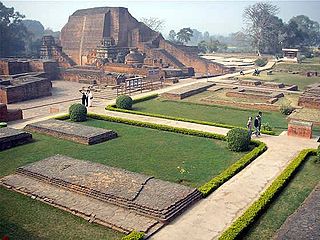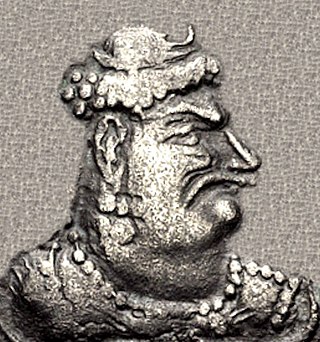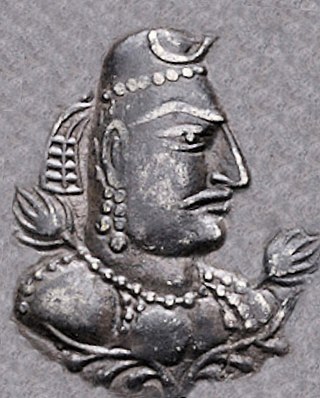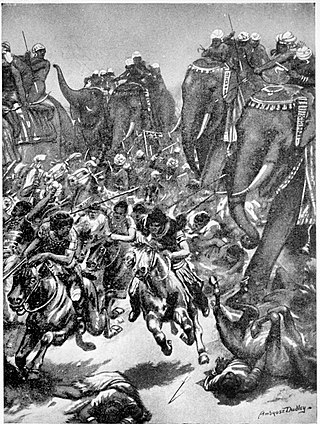
Punjab, also known as the Land of the Five Rivers, is a geopolitical, cultural, and historical region in South Asia. It is specifically located in the northwestern part of the Indian subcontinent, comprising areas of modern-day eastern-Pakistan and northwestern-India. Punjab's major cities are Lahore, Faisalabad, Rawalpindi, Gujranwala, Multan, Ludhiana, Amritsar, Sialkot, Chandigarh, Shimla, Jalandhar, Patiala, Gurugram, and Bahawalpur.

Xuanzang, born Chen Hui / Chen Yi, also known by his Sanskrit Dharma name Mokṣadeva, was a 7th-century Chinese Buddhist monk, scholar, traveler, and translator. He is known for the epoch-making contributions to Chinese Buddhism, the travelogue of his journey to India in 629–645 CE, his efforts to bring over 657 Indian texts to China, and his translations of some of these texts. He was only able to translate 75 distinct sections of a total of 1335 chapters, but his translations included some of the most important Mahayana scriptures.

Taxila or Takshashila is a city in the Pothohar region of Punjab, Pakistan. Located in the Taxila Tehsil of Rawalpindi District, it lies approximately 25 kilometres (16 mi) northwest of the Islamabad–Rawalpindi metropolitan area and is just south of the Haripur District of Khyber Pakhtunkhwa.

Harshavardhana was the Emperor of Kannauj of the Pushyabhuti dynasty who ruled northern India from year 606 to 647 CE. He was the son of Prabhakaravardhana who had defeated the Alchon Hun invaders, and the younger brother of Rajyavardhana, a king of Thanesar, present-day Haryana.

Buddhism, which originated in India, gradually dwindled and was replaced by approximately the 12th century. According to Lars Fogelin, this was "not a singular event, with a singular cause; it was a centuries-long process."

Major General Sir Alexander Cunningham was a British Army engineer with the Bengal Engineer Group who later took an interest in the history and archaeology of India. In 1861, he was appointed to the newly created position of archaeological surveyor to the government of India; and he founded and organised what later became the Archaeological Survey of India.

The Mahājanapadas were sixteen kingdoms or aristocratic republics that existed in ancient India from the sixth to fourth centuries BCE, during the second urbanisation period.

Buddhism was an important part of the classical Kashmiri culture, as is reflected in the Nilamata Purana and Kalhana's Rajatarangini. Buddhism is generally believed to have become dominant in Kashmir in the time of Emperor Ashoka, although it was widespread there long before his time, enjoying the patronage not only of Buddhist rulers but of Hindu rulers too. From Kashmir, it spread to the neighbouring Ladakh, Tibet and China proper. Accounts of patronage of Buddhism by the rulers of Kashmir are found in the Rajatarangini and also in the accounts of three Chinese visitors to Kashmir during 630-760 AD.

The history of Sindh refers to the history of the Pakistani province of Sindh, as well as neighboring regions that periodically came under its sway.

Mihirakula, sometimes referred to as Mihiragula or Mahiragula, was the second and last Alchon Hun king of northwestern region of the Indian subcontinent between 502 and 530 CE. He was a son of and successor to Toramana of Huna heritage. His father ruled the Indian part of the Hephthalite Empire. Mihirakula ruled from his capital of Sagala.
Hyderābād City (Haidarābād), headquarters of the district of Sindh province of Pakistan traces its early history to Neroon, a Sindhi ruler of the area from whom the city derived its previous name, Neroon Kot. Its history dates back to medieval times, when Ganjo Takker, a nearby hilly tract, was used as a place of worship. Lying on the most northern hill of the Ganjo Takker ridge, just east of the river Indus, it is the third largest city in the province and the eighth largest in the country with an expanse over three hillocks part of the most northerly hills of the Ganjo Takker range, 32 miles east of the Indus with which it is connected by various routes leading to Gidu Bandar.

Buddhism in Pakistan took root in the third century BCE under the Mauryan king Ashoka. The Major Rock Edicts of Ashoka inscribed on rock boulders in Mansehra and Shahbaz Garhi written in the Kharosthi script recording aspects of the emperor's dharma or righteous law represent some of the earliest evidence of deciphered writing in South Asia, dating to middle of the third century BCE. The Indo-Greek king Menander embraced Buddhism as attested in the Milinda Panha, which dates from sometime between 100 BC and 200 AD, following a dialogue with the monk Nāgasena in Sagala, present-day Sialkot.

Toramana also called Toramana Shahi Jauvla was a king of the Alchon Huns who ruled in northern subcontinent in the late 5th and the early 6th century CE. Toramana consolidated the Alchon power in Punjab, and conquered northern and central India including Eran in Madhya Pradesh. Toramana used the title "Great King of Kings", equivalent to "Emperor", in his inscriptions, such as the Eran boar inscription.

NarasimhaguptaBaladitya was the Gupta Emperor from 495 to 530 CE. He was son of Purugupta and probably the successor of Budhagupta.
Zunbil, also written as Zhunbil, or Rutbils of Zabulistan, was a royal dynasty south of the Hindu Kush in present southern Afghanistan region. They ruled from circa 680 AD until the Saffarid conquest in 870 AD. The Zunbil dynasty was founded by Rutbil, the elder brother of the Turk Shahi ruler, who ruled over Hephthalite kingdom from his capital in Kabul. The Zunbils are described as having Turkish troops in their service by Arabic sources like Tarikh al-Tabari and Tarikh-i Sistan.

The Alchon Huns, also known as the Alkhan, Alchono, Alxon, Alkhon, Alakhana, and Walxon, were a nomadic people who established states in Central Asia and South Asia during the 4th and 6th centuries CE. They were first mentioned as being located in Paropamisus, and later expanded south-east, into the Punjab and Central India, as far as Eran and Kausambi. The Alchon invasion of the Indian subcontinent eradicated the Kidarite Huns who had preceded them by about a century, and contributed to the fall of the Gupta Empire, in a sense bringing an end to Classical India.

The Battle of Sondani was a large military encounter fought in 528 CE, between the Alchon Hun emperor Mihirakula and a confederation of Indian rulers led by king Yashodharman of Malwa.

Moriya was an ancient Indo-Aryan tribe of northeastern Indian subcontinent whose existence is attested during the Iron Age. The Moriyas were organised into a gaṇasaṅgha, presently referred to as the Moriya Republic.
The emergence of the Great Kushans in Bactria and Northwestern India during the first century CE reshaped the geopolitical landscape of the region, impacting trade routes, international politics, and regional power dynamics. Economically, the Kushans served as intermediaries in trade, controlling crucial sections of the Silk Road and redirecting trade between China, India, and the eastern countries away from Parthian territory. This posed a significant economic challenge to the Parthians and positioned the Kushans as major players in international trade. Politically, the rise of the Kushans had profound implications for Iran, as it found itself sandwiched between the Roman Empire and the Kushans. The Romans recognized the strategic importance of the Kushan Empire and sought direct relations with its rulers to safeguard trade routes between Rome, China, and India. This geopolitical scenario led the early Sasanians to prioritize the conquest of the Kushan empire in their Eastern policy, eventually achieving remarkable success under Emperor Ardashir I. Following the decline of the Great Kushans, remnants known as the "Little Kushans" persisted in the Punjab region, eventually being subjugated by the Gupta Empire under Samudragupta. His inscription on the Allahabad pillar illustrates Gupta dominance over the last Kushan rulers, who were forced to accept Gupta suzerainty. Samudragupta's strategic alliances and military campaigns against the Sassanians and other regional powers solidified Gupta control over large parts of the Indian subcontinent. However, the Gupta Empire faced various challenges, including incursions by the Hunas, who posed a considerable threat to neighboring civilizations. Skandagupta's leadership and military strategy were crucial in resisting Huna advances, although the extent of damage caused by their invasions remains debated among scholars. Despite facing external pressures, internal succession issues within the Gupta dynasty, such as the question of rightful heirs, also contributed to the complexities of governance during that time.
The Hunnic invasion of the Gupta Empire was a pivotal event in ancient Indian history, facilitated by the administrative structure of the Gupta Empire, notably its feudal system. This structure allowed the Huna king to garner support from local chiefs, aiding in their invasion. The inscriptions discovered in Eran shed light on this dynamic.

















